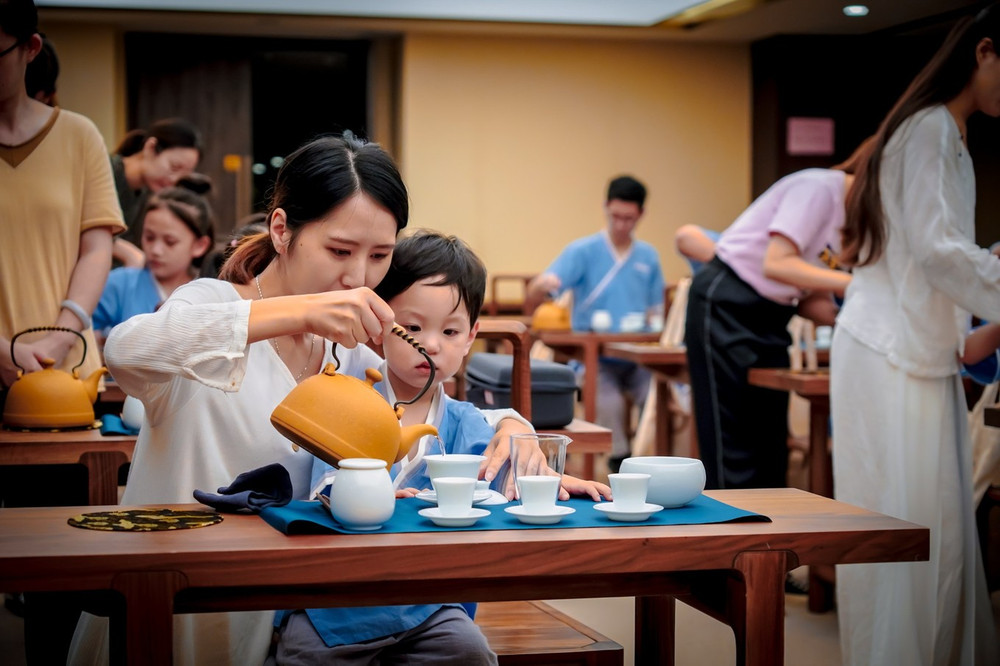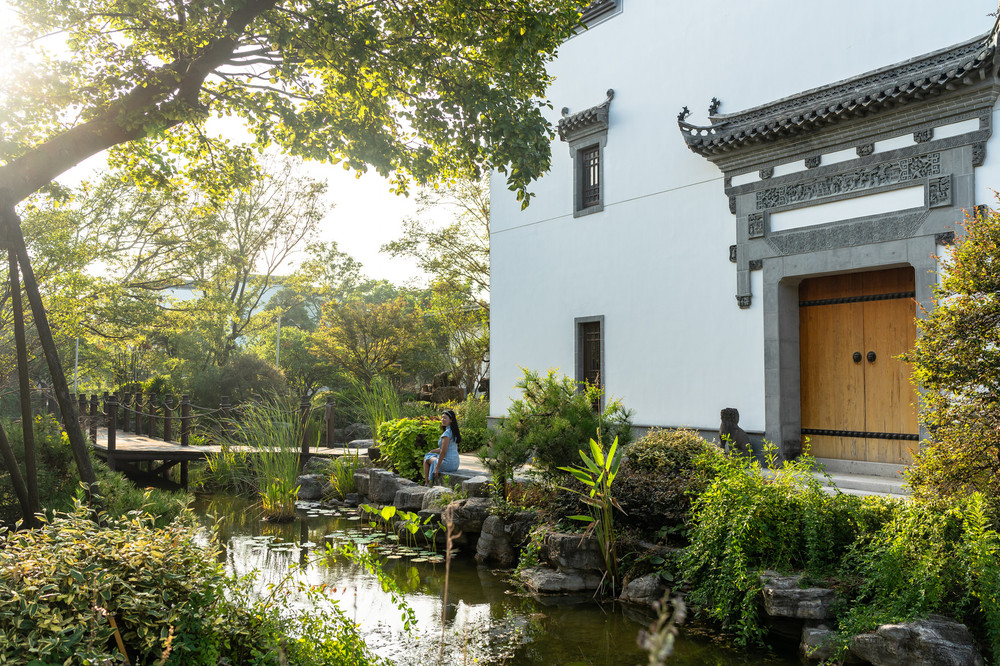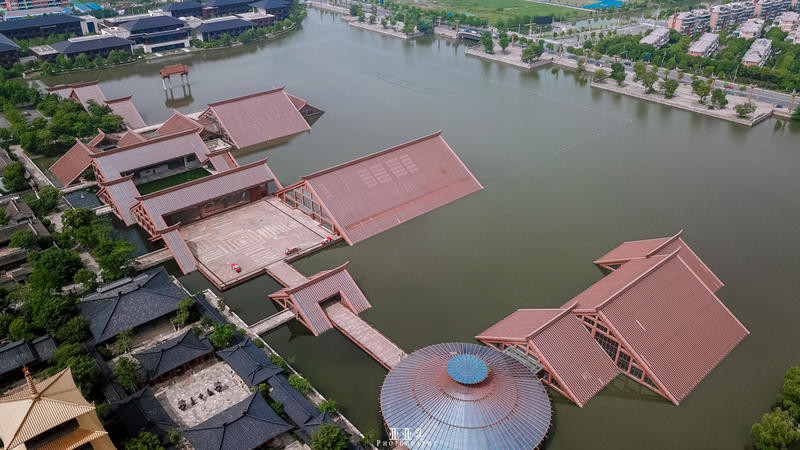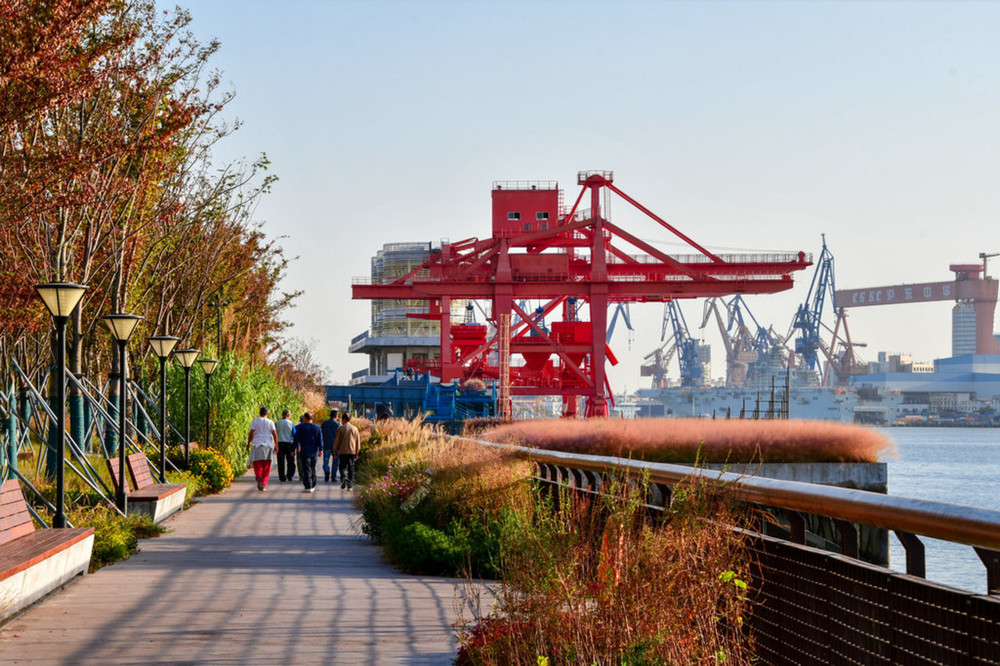Around the pool, there are numerous internet-famous restaurants offering delicious food with 360-degree unobstructed views and photo opportunities.
Sun Ke’s Former Residence: A Fusion of Styles
This Baroque-style building, once the ‘Shanghai Institute of Biological Products’ or ‘Shang Sheng Suo’, has never been open to the public until recently. On the wall, there is a row of doors in the park that can ‘change color’, with the color seen varying depending on the location or angle from which they are viewed, gathering all the colors of the rainbow.
Sun Ke, the son of Sun Yat-sen, lived in this small Western-style house designed by Laszlo Hudec, integrating a variety of styles including Spanish, Baroque, and Italian Renaissance.
Si Nan Open-Air Museum: A Humanistic Experience
Shaded by plane trees in the Si Nan Mansion, there is an ‘open-air museum’ without walls, glass display cases, fences, entrance fees, or one-meter lines. Established in 2016, it is a hundred-year-old humanistic museum that is always open, never closes, yet updates daily within the Si Nan Mansion.
Everything here, whether imaginable or unimaginable, may be an exhibit. Unlike traditional museums where exhibits are isolated by cold glass and blocked by strong railings, the open-air museum emphasizes approaching, entering, and comprehending exhibits.
All exhibits are vivid and natural, with less seriousness and more intimacy. Here, perhaps inadvertently walking, what you step on may be an exhibit.
The ‘Sinan Open-Air Museum’ has an extraordinary exhibition space and gathers various architectural forms such as independent garden villas, connected garden villas, row houses, veranda-style buildings, new-style lilongs, and modern apartments. It is a concentration area of modern residential buildings in Shanghai. Many buildings record a lot of precious history.
The well-known story of Mei Lanfang ‘growing a beard to show his aspiration’ happened here. No. 533, Fuxing Middle Road was once inhabited by a top student. He graduated from Yale University in the United States at the age of 27 with a master’s degree in physics and chemistry. At the age of 44, he entered politics and served as the finance minister of the then Nationalist government. Kong Xiangxi made contributions in currency reform, the peaceful settlement of the Xi’an Incident, and raising funds for the War of Resistance.
In addition to old villas, the exhibits also include street lamps, ancient trees, red brick roads, cobblestone walls, etc. On the outer wall of each exhibit, there is a shield-shaped sign with an exclusive QR code printed on it. You can listen to the voice introduction about this exhibit recorded by ‘ordinary people’ by scanning the code with WeChat on your mobile phone. However, we had no time to listen to the voice introduction and wasted an excellent learning opportunity.
Here are the former residences of famous scholars that inherit cultural context, the quietly growing plane tree shade, and the still breathing cobblestone walls… History here is not in a glass cover but in everyone’s perception and continuous creation.
This place is related to many celebrities, including Zhou Enlai, Mei Lanfang, Liu Yazi, Li Liejun, Cheng Qian, Xue Dubi, Zeng Pu, and so on. There is also the ‘Sinan Open-Air Museum · Time Alley’, connecting history and the future.
A ‘Time Alley’ is located in the north of the center of Sinan Mansions. It connects Fuxing Middle Road in the north and leads to the main street inside Sinan Mansions in the south. It is an alley about 30 meters long and 2 – 3 meters wide. In this narrow linear tunnel, the past, present, and future of Sinan are strung together.
Here, a mirror array composed of 26 two-way mirrors is closely arranged on both sides of the wall. History is a prism that can refract colorful lights. The stainless steel material with a golden mirror surface interacts with visiting tourists against the black background. The visitors walking among them seem to be walking in their own 26 overlapping images, as if walking in history with countless ‘me’ at different times.
History and the present are having a warm and profound dialogue here. In Time Alley, there are Feng Yuxiang, Mei Lanfang, Zhang Xueliang… and also us now.
Some of the exhibits in the entire open-air museum are buildings, some are people in the buildings, some may be street lamps, ancient trees, cobblestone walls, etc. All of these have little-known stories and carry a heavy historical accumulation.
In this open-air museum without glass showcases or fences, people are both visitors to history and creators of history. The past is not far away, and the future has arrived.
The environment here is excellent and the architecture is unrivaled. Every western-style house, every staircase, and every alley are worth taking pictures. I still want to quietly experience it again.
For dinner, we had local Shanghai cuisine. In my impression, Shanghai cuisine is on the sweet side, but these dishes are very salty. After that, we went to the City God Temple to see the night view.
Seeing Sister Xiaowen from the same group taking pictures, I went over and struck up a conversation with her: “I’m afraid of getting lost. I’ll follow you.” Sister Xiaowen said: “Sure, sure.” She is a woman with a rare strong sense of direction.
There is an old saying in Shanghai that “if you go to Shanghai but don’t visit the City God Temple, it’s like you haven’t been to Greater Shanghai.” The City God Temple has become a landmark attraction in Shanghai.
The City God Temple originated from the ancient sacrifices to water (huang) and moat (cheng) and is one of the eight gods in the “Zhou Palace”. In ancient times, people built cities to protect the safety of the people in the city, so they built tall city walls, towers, city gates, moats, and city moats. This is the origin of the City God Temple.
The lights are bright and resplendent. The ancient buildings are blurred and mysterious under the illumination of lights. Perhaps due to the impact of the epidemic, there
Shanghai’s Culinary Delights
Changsha stinky tofu and old yogurt, though not locally produced, have found their place in Shanghai’s food scene with stalls and shops. You can indulge to your heart’s content. The City God Temple in Shanghai is renowned for its array of Shanghai-style snacks, making the area around it a veritable kingdom of snacks.



